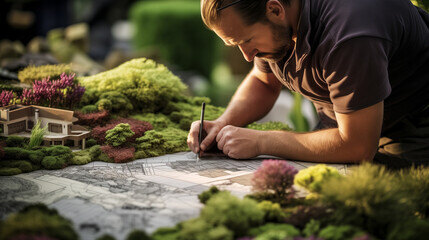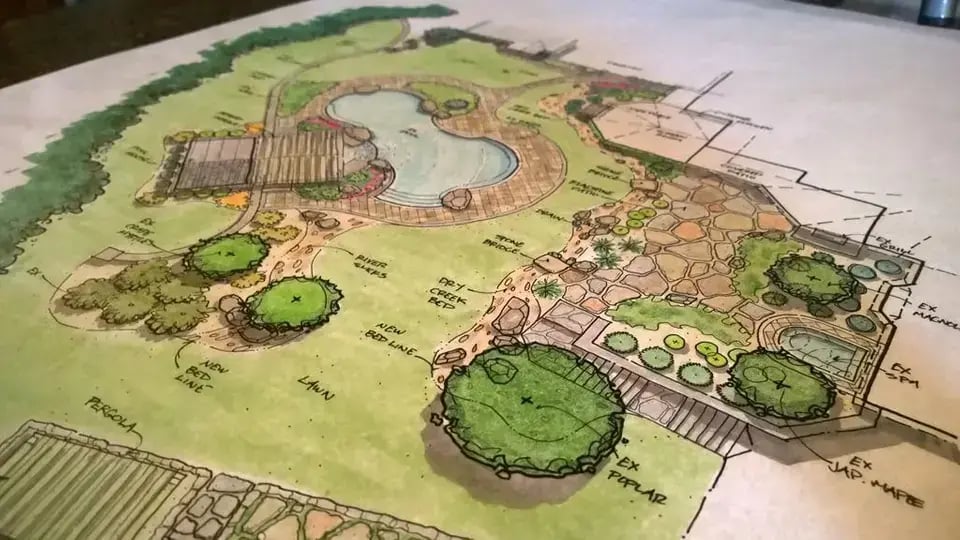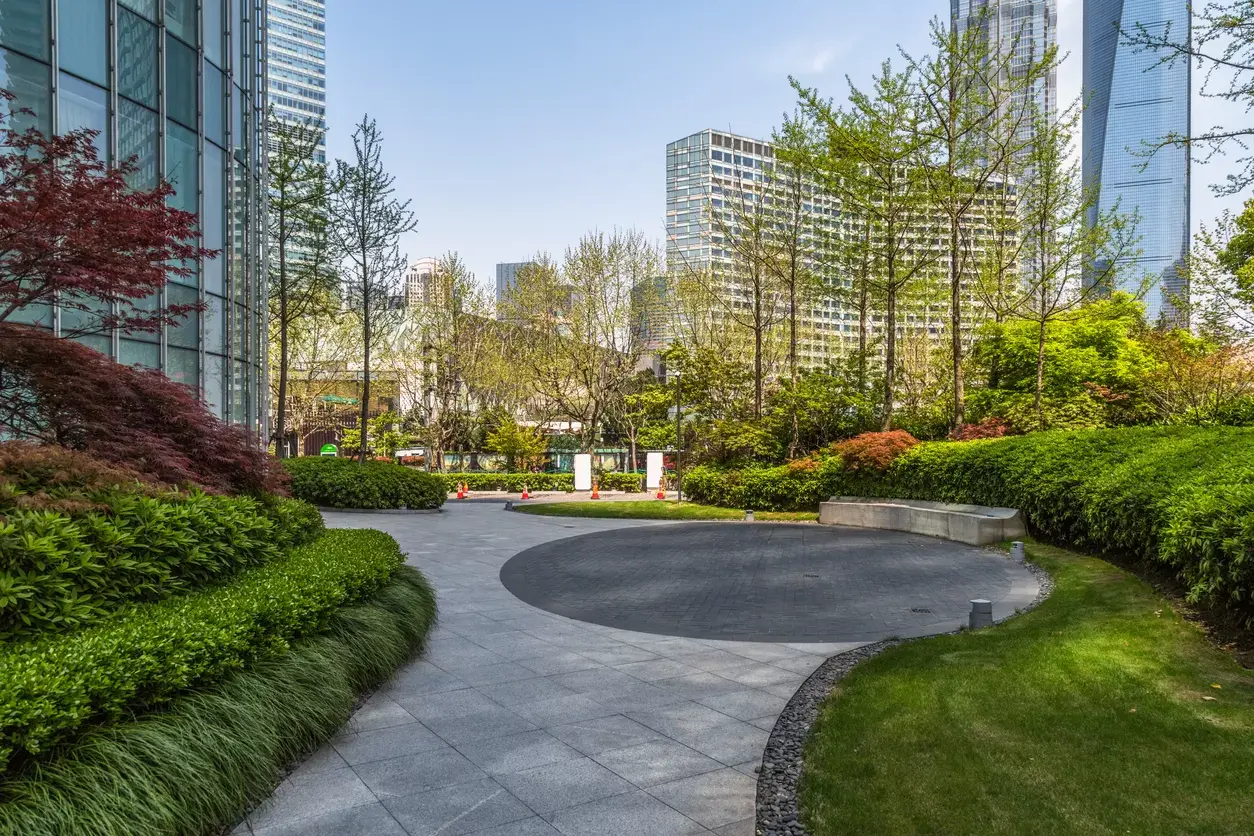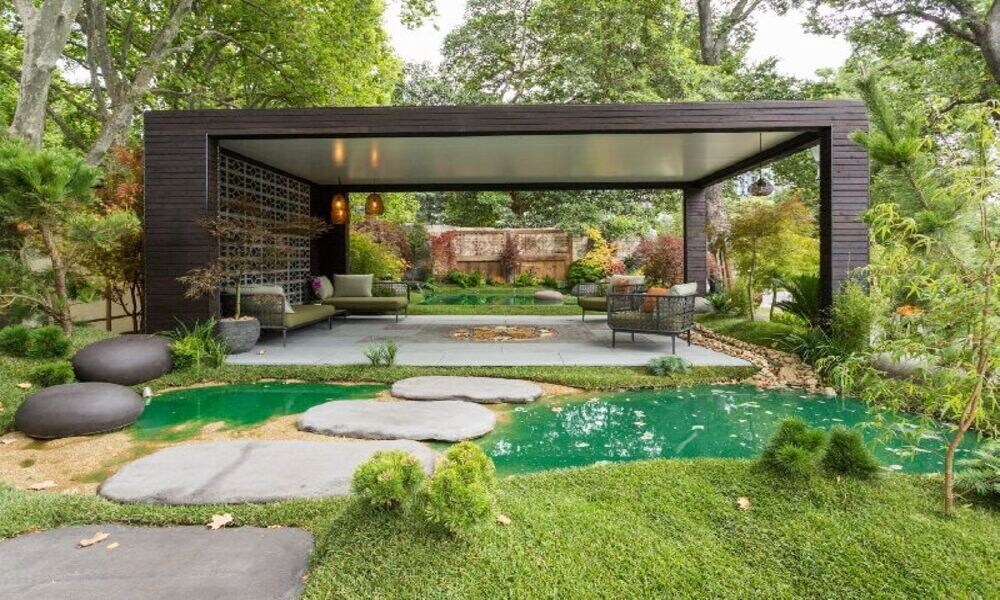How to Become a Landscape Designer: Key Skills & Training
.jpg)
Table of Contents
If you are exploring how to become a landscape designer, you are stepping into a field that blends creativity, environment, and technical skill. Landscape designers plan and shape outdoor spaces so they are beautiful, functional, and sustainable.
As demand grows for climate-responsive design, green infrastructure, and thoughtfully planned outdoor environments, the role of a landscape designer has become more important than ever. Whether you aim to work on residential gardens, public parks, campuses, or urban landscapes, developing the right blend of design and technical knowledge is essential.
Learn how to become a landscape designer with essential skills, top certifications, and industry-ready training. This guide covers key responsibilities, software expertise, sustainable design practices, and the best landscape design courses to start your career. Ideal for aspiring designers passionate about transforming outdoor spaces and building high-growth careers in landscape architecture.
Understanding the Role of Landscape Designers
Landscape designers plan and shape outdoor spaces by combining design, plant knowledge, and technical skills. They work across gardens, parks, campuses, and public spaces to improve comfort, ecology, and visual quality while meeting client and community needs.
Landscape design is a blend of creativity and technical skill. Landscape designers create beautiful and sustainable outdoor spaces, enhancing the beauty of surroundings and improving quality of life. As the modern world is evolving, the demand for landscape designers is growing and landscape design jobs are becoming increasingly crucial. Let’s explore the skills, responsibilities, and scope of work of the landscape designer in detail.
What is Landscape Designing?
Landscape designing involves planning, creating, and managing outdoor spaces. It combines art and science to develop aesthetically pleasing and functional environments. The goal is to enhance the natural beauty of an area while ensuring it serves practical purposes such as recreation, relaxation, or sustainability. Landscape design encompasses everything - private gardens, public parks, commercial properties, and urban spaces.
Who is a Landscape Designer?
A landscape designer is a professional who specialises in creating outdoor spaces. They use their knowledge of plants, soil, and design principles to transform landscapes into beautiful and functional areas. Landscape designers work on a variety of projects, including residential gardens, public parks, and commercial properties. They collaborate with clients to understand their needs and preferences and then develop plans that bring those visions to life.
Scope of Work for Landscape Designers
The scope of work for landscape designers covers site analysis, client consultation, concept design, detailed drawings, plant selection, coordination with contractors, and basic project management, ensuring outdoor spaces are buildable, maintainable, and aligned with user needs.
The day-to-day work of a landscape designer goes far beyond sketching. It involves research, design, documentation, and on-site coordination to make sure the final landscape matches the original vision and performs well over time.
The scope of work for a landscape designer is vast and diverse, encompassing various tasks and responsibilities aimed at creating beautiful and functional outdoor spaces. Here is a detailed look at what landscape designers do:
- Consultation and Planning: One of the first steps in landscape designing is consulting with clients. Landscape designers meet with clients to understand their needs, preferences, and budget. This initial consultation is crucial for setting the project’s direction and ensuring that the final design aligns with the client’s vision.
- Design Creation: Once the initial consultation and site analysis are complete, the landscape designer moves on to creating the design. This involves developing landscape designs, drawings and plans that outline the placement of plants, structures, and other elements. Many designers use online landscaping design software to create detailed and accurate plans. These tools allow for the visualisation of the final design, making it easier to make adjustments and ensure that everything fits perfectly.
- Project Management: Landscape designers often oversee the implementation of their designs. This involves coordinating with contractors, suppliers, and other professionals to ensure that the project is completed on time and within budget. Effective project management skills are essential to handle these tasks efficiently.
- Plant Selection: Choosing the right plants is a critical part of the landscape design process. Landscape designers must have a deep knowledge of various plant species, including their growth habits, maintenance needs, and compatibility with the local climate. The goal is to select plants that will thrive in the environment and contribute to the overall beauty and functionality of the space.
- Site Analysis: Before starting any design work, landscape designers conduct a thorough site analysis. This involves assessing the site’s soil, climate, and existing vegetation. Understanding these factors is essential for creating a design that is both aesthetically pleasing and sustainable.
Key Technical Skills of Landscape Designers
To become a landscape designer, you need technical skills in design software, hardscape detailing, plant knowledge, basic grading and drainage, and visual communication, along with the ability to coordinate with contractors and other design professionals.
Here are four key technical skills every landscape designer should have:
- Proficiency in Design Software: To create precise and detailed landscape design drawing, proficiency in design software is crucial. There are a plethora of tools like AutoCAD and SketchUp to help designers visualise their ideas and make necessary adjustments easily. These programs are essential for presenting designs to clients and ensuring everything fits perfectly within the given space.
- Hardscaping Techniques: Landscape designers must also be skilled in hardscaping, which includes designing elements like patios, walkways, and retaining walls. Understanding materials and construction techniques ensures these elements integrate well with the overall landscape designs. Hardscaping adds structure and functionality, making outdoor spaces more usable and attractive.
- Knowledge of Plant Species: Understanding different plant species, their growth habits, and maintenance needs is vital. This knowledge allows landscape designers to choose the right plants for specific environments, ensuring that the outdoor landscape design remains beautiful and healthy over time. Knowing how to select plants that thrive in particular climates and soil types is a fundamental skill.
Also Read: Architecture Thesis Topics: A Comprehensive List of 30 Topics to Pick From 2025
Importance of Landscape Designers in the Job Market
Landscape designers ar e increasingly important in today's job market. Here are some of the pointers, explaining their importance in detail:
- Urban Development: As urban areas expand, there is a growing need for public and private outdoor landscape designs. Landscape designers create parks, gardens, and recreational areas that improve the quality of urban living. These spaces provide residents with areas for relaxation and recreation, enhancing the overall well-being of communities.
- Increasing Property Value: A well-designed landscape can significantly increase the value of residential and commercial properties. Attractive and functional outdoor landscapes make properties more appealing to buyers and tenants, driving up their market value. This makes landscape design jobs essential in the real estate industry.
- Diverse Career Opportunities: The landscape design field offers a wide range of career opportunities. From working in private firms and government agencies to freelancing and starting your own business, there are numerous paths one can take. Obtaining a landscape design certificate online or enrolling in a landscape design program free can open doors to these exciting and rewarding careers.
- Environmental Impact: Landscape designers play a crucial role in promoting environmental sustainability. By incorporating green practices in their landscape designs, they help conserve water, improve soil health, and support local ecosystems through the use of native plants. These efforts contribute to a healthier environment and more sustainable urban development.
How to Become a Landscape Designer?
If you want to know how to become a landscape designer, start with a design or related degree, build software and plant skills, add focused landscape courses, and develop a strong portfolio with real or simulated site-based projects.
Becoming a landscape designer involves a combination of education, practical experience, and a passion for creating beautiful outdoor spaces. Here is a guide on the educational background and qualifications required to embark on this rewarding career path:
1. Educational Qualification
- Bachelor’s Degree in Landscape Architecture or Design: A bachelor’s degree in landscape architecture or design is a common starting point. This degree covers essential topics such as design principles, plant science, and landscape design drawing. It provides a solid foundation for understanding both the artistic and technical aspects of landscape design.
- Landscape Design Certificate Online Programs: Many aspiring landscape designers choose to enhance their qualifications through landscape design certificate online programs. These programs offer flexibility and cover various aspects of landscape design, from sustainable practices to advanced design techniques. They are particularly useful for those who wish to continue working while studying.
- Associate Degree in Landscape Design: For those looking for a quicker entry into the field, an associate degree in landscape design can be a good option. These programs take two years to complete and focus on the basics of outdoor landscape design, horticulture, and the use of design software.
2. Essential Qualifications
- Proficiency in Design Software: Mastering design software like AutoCAD, SketchUp, and other tools used for landscape design drawing is essential. These programs help you create detailed plans and visualisations that are crucial for client presentations and project planning.
- Certification and Licensing: Depending on where you live, you may need to obtain a professional licence to work as a landscape designer. Certification from recognised bodies can also boost your credibility. Look for programs that offer certification upon completion, such as a landscape design program that aligns with industry standards.
- Sustainable Design Practices: With the growing emphasis on sustainability, knowledge of eco-friendly design practices is increasingly important. Learning about water conservation, soil health, and the use of native plants can set you apart in the job market. Many landscape design certificate online programs now include modules on sustainability.
Top Landscape Designer Training & Certification Courses
Becoming a successful landscape designer involves more than just learning about the environment and nature. It requires specific skills and learning that can be gained through the dedicated landscape design courses. Here are some of the top training and certification courses that can help you on your journey to becoming a landscape designer.
1. BIM Professional Course for Architects - Novatr
The BIM Professional Course for Architects is one of the best landscape design courses in theindustry. It is offered by Novatr and is an excellent program for those interested in learning BIM (Building Information Modeling) with landscape design and architecture. This course provides comprehensive training on BIM tools and techniques, which are essential for modern landscape design projects.
What it Offers:
- In-depth understanding of BIM software like Revit and Navisworks.
- Hands-on projects that simulate real-world landscape design challenges.
- Modules on project management and collaboration within design teams.
Benefits of the Course:
- Enhances your technical skills in using advanced design software.
- Prepares you for the evolving demands of the landscape designer job.
- Increases your employability and potential landscape design salary by equipping you with cutting-edge skills.
- Comes with placement assistance.
2. A Business Approach to Sustainable Landscape Restoration - Coursera
This Coursera course is ideal for those who want to combine their passion for landscape design with sustainability. This course teaches how to create landscapes that are not only beautiful but also environmentally sustainable.
What it Offers:
- Concepts of sustainable landscape restoration and the principles of ecology.
- Business strategies for implementing sustainable practices in landscape projects.
- Case studies and real-life examples of successful sustainable landscapes.
Benefits of the Course:
- Equips you with knowledge about sustainable practices that are increasingly important in the industry.
- Provides a unique perspective on combining business and environmental stewardship.
- Prepares you to address the growing demand for sustainable landscape design solutions.
3. Diploma in Landscaping Course - International Career Institute
The Diploma in Landscaping Course from the International Career Institute is an amazing program for landscape design that covers all aspects of landscape design. This course is designed for those who want a thorough grounding in both the artistic and practical elements of landscaping.
What it Offers:
- Modules on design principles, plant selection, and garden construction.
- Lessons on landscape business management and client relations.
- Practical projects that build your portfolio and hands-on skills.
Benefits of the Course:
- Provides a well-rounded education that prepares you for various roles within the landscape designer job description.
- Helps you develop a professional portfolio to showcase your skills.
- Increases your confidence and competence in handling real-world landscape projects.
Also Check out: Landscape Architecture: Definitions, Types, Elements & More
4. Post Graduate Diploma in Landscape Design - Bangalore School of Design and Technology
The Post Graduate Diploma in Landscape Design at the Bangalore School of Design and Technology is one of the prominent landscape design courses and prestigious program that offers advanced training in landscape design. This course is suitable for those looking to deepen their expertise and take on leadership roles in the field.
What it Offers:
- Advanced courses on landscape architecture, urban design, and environmental planning.
- Opportunities to work on large-scale projects and research initiatives.
- Mentorship from experienced professionals and academics in the field.
Benefits of the Course:
- Provides in-depth knowledge and skills required for advanced roles in landscape design.
- Prepares you for higher-level positions with a comprehensive understanding of landscape architecture and planning.
- Enhances your qualifications and increases your potential landscape design salary.
5. Sustainability in Landscape Design - Udemy
Udemy's Sustainability in Landscape Design course is another program for landscape design focused on creating eco-friendly and sustainable buildings. This course is perfect for those who want to incorporate green practices into their design philosophy.
What it Offers:
- Techniques for reducing environmental impact through design.
- Strategies for water conservation, soil health, and native planting.
- Practical examples of sustainable design in various settings.
Benefits of the Course:
- Learn practical skills that are crucial for modern landscape design.
- Understand how to create designs that are both beautiful and sustainable.
- Gain a competitive edge in the job market by mastering sustainable design techniques.
Also Read: 20 Marvellous Long-Span Structures That Will Blow Your Mind
Conclusion
In today's world, where the demand for sustainable and functional outdoor landscape designs is growing, continuous learning and staying updated with the latest trends are crucial. By pursuing the right education and gaining relevant certifications, you can enhance your skills and increase your employability in landscape design jobs. Becoming a successful landscape designer requires a combination of education, practical experience, and a passion for creating beautiful outdoor spaces.
Start your journey today by applying for the BIM Professional Course for Architects offered by Novatr and other reputable institutions. Visit our Resources page for more information and take the first step towards a rewarding career in landscape design.
FAQs
1. What is required to become a Landscape Designer?
To become a landscape designer, you typically need a design-related degree or diploma, basic knowledge of plants and materials, skill in design software, and a strong portfolio. Short courses and certifications in landscape design and sustainability further strengthen your profile.
2. What qualifications do I need for landscaping?
For professional landscaping and landscape designing, employers usually look for a diploma or degree in landscape architecture, landscape design, architecture, or horticulture. Added certificates in design software, planting design, and sustainable practices makes you more competitive in the job market.
3. How to become a Landscape Designer in India?
In India, start with a related degree or diploma, then take focused landscape design courses and software training. Build a portfolio using studio work, freelance projects, or internships, and apply to landscape firms, architecture practices, or urban design studios for entry-level roles.
4. What is the rule of 3 in landscaping?
The rule of 3 in landscape design usually refers to using plants or elements in groups of three for better visual balance. Odd-number groupings feel more natural and less rigid than even-number groupings, helping compositions look more relaxed and dynamic.
5. What is the salary of landscape designer in India?
The salary of a landscape designer in India depends on the city, experience, and type of employer. Freshers may start on a modest package, while experienced designers in large firms or niche studios can earn higher pay, especially with strong software and sustainability skills.

 Thanks for connecting!
Thanks for connecting!


.png)



.jpg)
.png)

